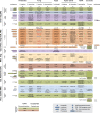Evolution and diversification of the nuclear pore complex
- PMID: 34282823
- PMCID: PMC8421043
- DOI: 10.1042/BST20200570
Evolution and diversification of the nuclear pore complex
Abstract
The nuclear pore complex (NPC) is responsible for transport between the cytoplasm and nucleoplasm and one of the more intricate structures of eukaryotic cells. Typically composed of over 300 polypeptides, the NPC shares evolutionary origins with endo-membrane and intraflagellar transport system complexes. The modern NPC was fully established by the time of the last eukaryotic common ancestor and, hence, prior to eukaryote diversification. Despite the complexity, the NPC structure is surprisingly flexible with considerable variation between lineages. Here, we review diversification of the NPC in major taxa in view of recent advances in genomic and structural characterisation of plant, protist and nucleomorph NPCs and discuss the implications for NPC evolution. Furthermore, we highlight these changes in the context of mRNA export and consider how this process may have influenced NPC diversity. We reveal the NPC as a platform for continual evolution and adaptation.
Keywords: eukaryogenesis; evolutionary biology; nuclear pores; nuclear protein transport.
© 2021 The Author(s).
Conflict of interest statement
The authors declare that there are no competing interests associated with the manuscript.
Figures




References
Publication types
MeSH terms
Substances
Grants and funding
LinkOut - more resources
Full Text Sources

